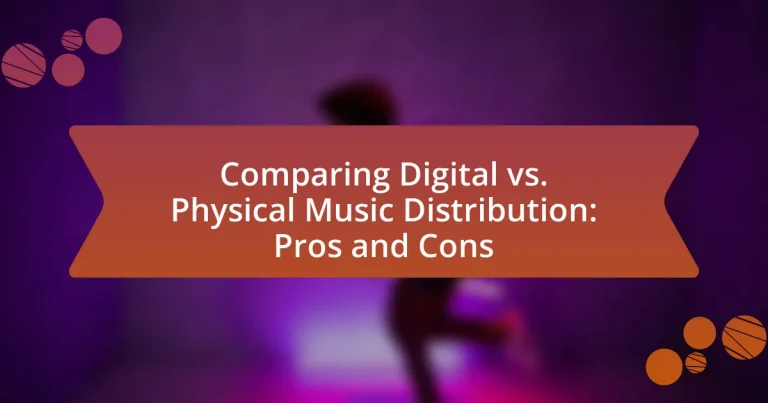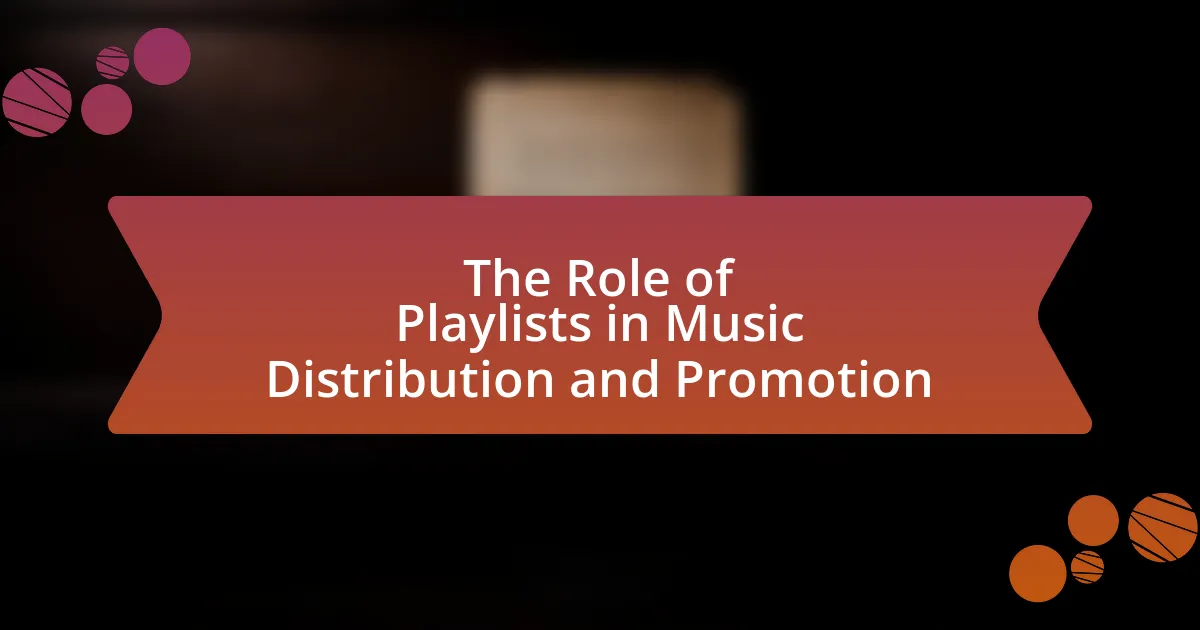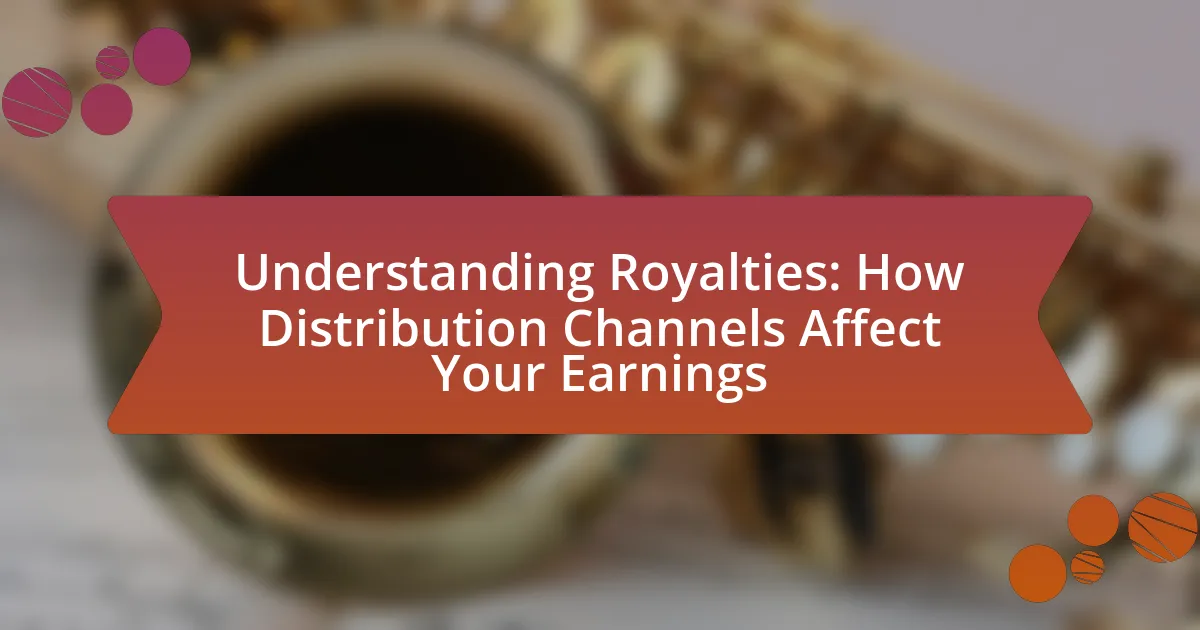The article examines the key differences between digital and physical music distribution, highlighting their respective advantages and disadvantages. Digital distribution offers instant access, global reach, and lower costs, while physical distribution provides tangible ownership and collectible value but incurs higher production and logistics expenses. The article details how digital platforms operate, the technical requirements for distribution, and the challenges artists face in both formats, including revenue implications and market saturation. Additionally, it explores how artists can effectively choose between these distribution methods based on their target audience, budget, and marketing strategies.
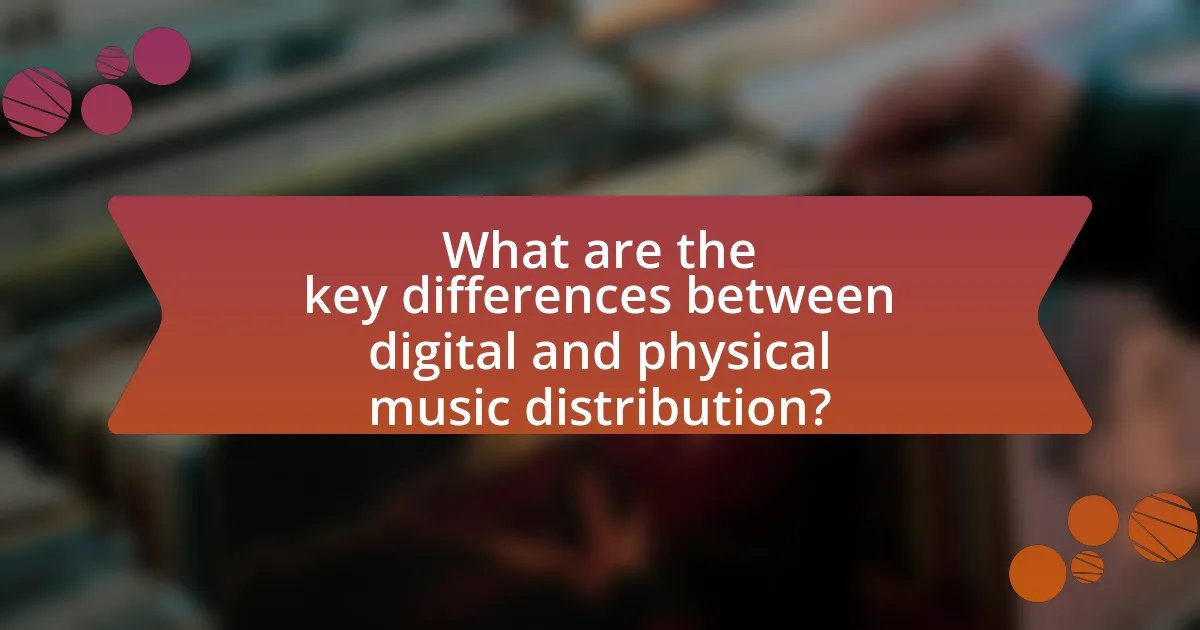
What are the key differences between digital and physical music distribution?
Digital music distribution involves the delivery of music through online platforms, allowing for instant access and global reach, while physical music distribution relies on tangible formats like CDs and vinyl, which require manufacturing and shipping. Digital distribution enables artists to reach audiences without geographical limitations, as evidenced by the rise of streaming services like Spotify, which reported over 400 million users in 2021. In contrast, physical distribution often incurs higher costs due to production and logistics, with the Recording Industry Association of America noting that physical sales have declined significantly, accounting for only 10% of total music revenue in recent years.
How does digital music distribution operate?
Digital music distribution operates by delivering music content electronically through various online platforms, allowing artists and labels to reach consumers directly. This process typically involves the use of digital aggregators or distributors, which facilitate the uploading of music to streaming services and online stores like Spotify, Apple Music, and Amazon Music. These distributors manage licensing, royalties, and metadata, ensuring that artists receive compensation for their work. According to the International Federation of the Phonographic Industry (IFPI), digital music revenues accounted for 62.1% of the global recorded music market in 2020, highlighting the significance and efficiency of digital distribution in the modern music industry.
What platforms are commonly used for digital music distribution?
Common platforms used for digital music distribution include Spotify, Apple Music, Amazon Music, and Tidal. These platforms enable artists and labels to distribute their music globally, reaching millions of listeners. For instance, as of 2023, Spotify boasts over 500 million active users, making it one of the largest streaming services available. Additionally, Apple Music has over 88 million subscribers, further demonstrating the significant reach and impact of these platforms in the music industry.
What are the technical requirements for digital music distribution?
The technical requirements for digital music distribution include high-quality audio files, metadata standards, and compliance with digital rights management (DRM). High-quality audio files typically need to be in formats such as WAV, FLAC, or high-bitrate MP3 to ensure sound fidelity. Metadata standards require accurate tagging of information like artist name, album title, track number, and genre, which is essential for proper cataloging and searchability on platforms. Compliance with DRM is necessary to protect the intellectual property rights of the music creators and ensure that the distribution adheres to licensing agreements. These requirements are critical for successful digital music distribution across various platforms and services.
How does physical music distribution function?
Physical music distribution functions through a network of manufacturers, distributors, and retailers that facilitate the production and sale of physical music formats, such as CDs, vinyl records, and cassette tapes. The process begins with music labels or artists producing physical copies of their music, which are then sent to distributors. Distributors handle the logistics of getting these products to various retail outlets, including record stores and online platforms. Retailers then sell the physical music to consumers. According to the Recording Industry Association of America (RIAA), physical music sales accounted for approximately 10% of total music revenue in 2022, highlighting the ongoing relevance of physical formats despite the rise of digital distribution.
What are the traditional methods of physical music distribution?
Traditional methods of physical music distribution include vinyl records, cassette tapes, and compact discs. These formats were widely used from the mid-20th century until the rise of digital music. Vinyl records, introduced in the late 1940s, became a staple for music consumption, while cassette tapes gained popularity in the 1970s for their portability. Compact discs, launched in the early 1980s, offered improved sound quality and durability, leading to their dominance in the 1990s. Each of these formats was distributed through retail stores, music shops, and direct sales at concerts, establishing a physical presence in the music market.
What logistics are involved in physical music distribution?
Physical music distribution involves several logistics, including manufacturing, warehousing, transportation, and retail placement. Manufacturing entails producing physical formats such as CDs, vinyl, or cassettes, which requires coordination with pressing plants and suppliers. Warehousing involves storing the finished products until they are ready for distribution, necessitating inventory management systems to track stock levels. Transportation logistics include selecting carriers and managing shipping routes to deliver products to retailers or directly to consumers, ensuring timely and cost-effective delivery. Retail placement requires negotiating shelf space and promotional strategies with retailers to maximize visibility and sales. These logistics are critical for ensuring that physical music products reach their intended markets efficiently and effectively.
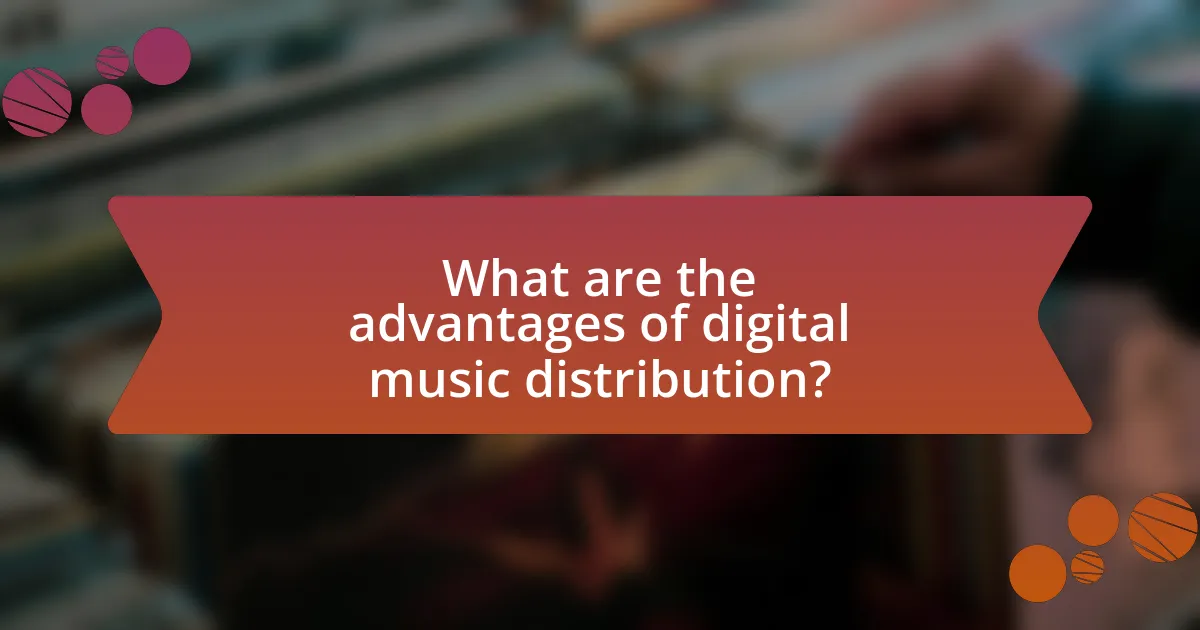
What are the advantages of digital music distribution?
Digital music distribution offers several advantages, including wider reach, lower costs, and instant accessibility. The ability to distribute music globally through platforms like Spotify and Apple Music allows artists to connect with audiences without geographical limitations. Additionally, digital distribution eliminates the need for physical production, reducing costs associated with manufacturing, shipping, and storage. Instant accessibility means that consumers can purchase and listen to music immediately, enhancing user experience and driving sales. According to a report by the International Federation of the Phonographic Industry (IFPI), digital music revenues accounted for 62% of the global recorded music market in 2020, highlighting the effectiveness of digital distribution in reaching consumers.
How does digital distribution enhance accessibility for artists?
Digital distribution enhances accessibility for artists by allowing them to reach global audiences without the barriers of physical distribution. This method eliminates the need for physical inventory, reducing costs and enabling artists to upload their work to platforms like Spotify and Apple Music instantly. According to a report by the International Federation of the Phonographic Industry, digital music revenues accounted for 56.1% of the global recorded music market in 2020, illustrating the significant shift towards digital platforms. This accessibility empowers independent artists to distribute their music widely, engage with fans directly, and retain a larger share of their earnings compared to traditional physical distribution methods.
What role do streaming services play in digital music distribution?
Streaming services serve as the primary platform for digital music distribution, enabling artists to reach global audiences instantly. These platforms, such as Spotify and Apple Music, provide access to vast music libraries, allowing users to stream songs on-demand rather than purchasing individual tracks or albums. In 2022, streaming accounted for over 83% of the U.S. music industry’s revenue, highlighting its dominance in the market. This shift has transformed how music is consumed, with listeners favoring subscription models that offer unlimited access to music over traditional purchasing methods.
How does digital distribution impact global reach for musicians?
Digital distribution significantly enhances global reach for musicians by allowing them to distribute their music worldwide without geographical limitations. Unlike physical distribution, which is constrained by logistics and retail partnerships, digital platforms enable artists to upload their music to streaming services and online stores accessible to a global audience. For instance, platforms like Spotify and Apple Music have millions of users across various countries, providing musicians with the opportunity to reach listeners in diverse markets instantly. This accessibility is evidenced by the fact that in 2022, global music streaming revenue reached approximately $16.9 billion, highlighting the effectiveness of digital distribution in expanding audience reach.
What cost benefits does digital music distribution offer?
Digital music distribution offers significant cost benefits, primarily through reduced production and distribution expenses. Unlike physical music distribution, which incurs costs for manufacturing CDs, vinyl, and packaging, digital distribution eliminates these expenses, allowing artists and labels to allocate resources more efficiently. For instance, a report by the International Federation of the Phonographic Industry (IFPI) indicates that digital distribution can reduce costs by up to 80% compared to traditional methods. Additionally, digital platforms enable artists to reach global audiences without the need for physical inventory, further decreasing overhead costs associated with storage and shipping.
How do production and distribution costs compare between digital and physical formats?
Production and distribution costs for digital formats are significantly lower than those for physical formats. Digital music eliminates the need for manufacturing, packaging, and shipping, which are substantial expenses associated with physical formats like CDs or vinyl records. For instance, producing a CD can cost between $1 to $2 per unit, while digital distribution costs are often a fraction of a cent per download or stream, primarily involving server and bandwidth fees. Additionally, physical formats incur costs related to inventory management and retail distribution, which digital formats do not face, further emphasizing the cost efficiency of digital music distribution.
What are the financial implications for independent artists using digital distribution?
Independent artists using digital distribution typically experience lower upfront costs and higher profit margins compared to traditional physical distribution. Digital platforms eliminate the need for manufacturing, shipping, and storage costs associated with physical products, allowing artists to retain a larger percentage of sales revenue. For instance, services like Bandcamp and DistroKid enable artists to distribute their music globally with minimal fees, often taking a small percentage of sales rather than charging upfront costs. This model can lead to increased earnings, as independent artists can sell directly to consumers without intermediaries, resulting in a more favorable financial outcome. Additionally, the global reach of digital distribution allows for potential sales in diverse markets, further enhancing revenue opportunities.
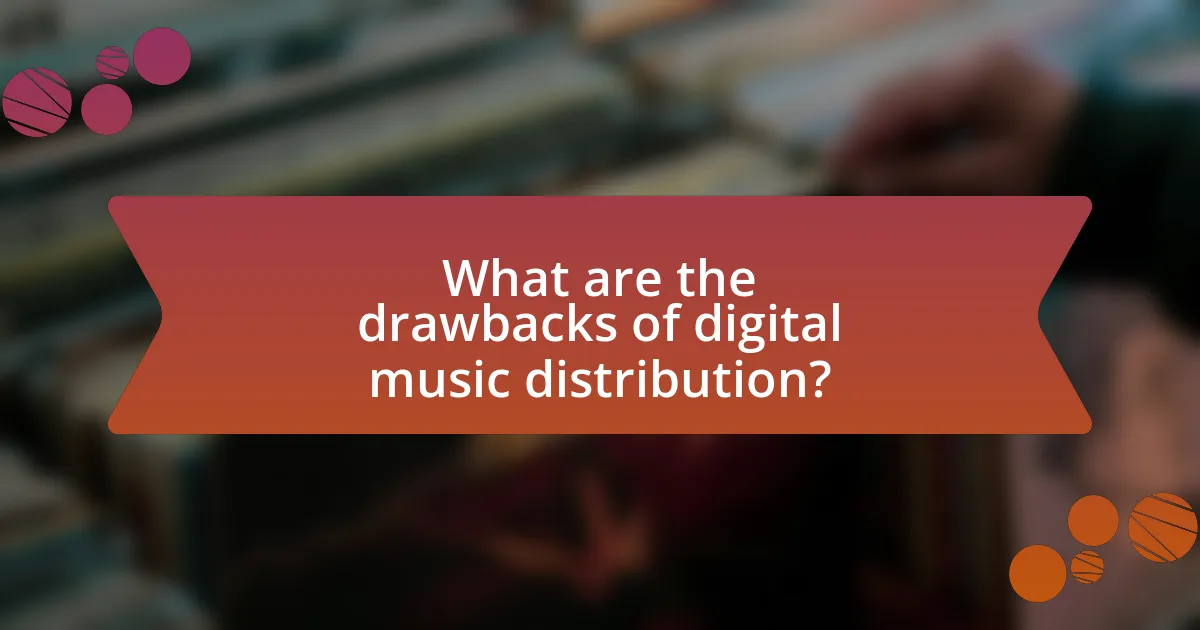
What are the drawbacks of digital music distribution?
The drawbacks of digital music distribution include issues such as lower revenue for artists, lack of physical ownership, and increased piracy risks. Digital platforms often pay artists a fraction of a cent per stream, which significantly reduces their overall earnings compared to physical sales. Additionally, consumers do not own digital music in the same way they own physical copies, leading to concerns about access and permanence. Furthermore, the ease of copying and sharing digital files contributes to widespread piracy, undermining the financial viability of the music industry. These factors collectively challenge the sustainability of artists’ careers in a predominantly digital landscape.
What challenges do artists face with digital music distribution?
Artists face several challenges with digital music distribution, including market saturation, revenue loss, and lack of control over pricing. The digital music landscape is highly competitive, with millions of tracks available, making it difficult for individual artists to stand out. According to a report by the International Federation of the Phonographic Industry (IFPI), streaming services account for over 60% of global recorded music revenue, yet artists often receive a fraction of a cent per stream, leading to significant revenue loss compared to traditional sales. Additionally, artists frequently have limited control over how their music is priced and marketed on various platforms, which can hinder their ability to maximize earnings and reach their target audience effectively.
How does digital piracy affect artists and labels?
Digital piracy negatively impacts artists and labels by significantly reducing their potential revenue. According to a report by the Institute for Policy Innovation, the U.S. music industry lost approximately $12.5 billion annually due to piracy in 2017. This loss occurs because unauthorized downloads and streaming diminish sales of legitimate music, leading to decreased income for artists and labels. Furthermore, the prevalence of piracy can undermine the perceived value of music, making consumers less willing to pay for legal copies. This economic strain affects not only major labels but also independent artists who rely on sales for their livelihood.
What are the limitations of digital music platforms?
Digital music platforms have several limitations, including issues related to sound quality, ownership rights, and accessibility. Sound quality on streaming services often suffers due to compression algorithms, which can degrade audio fidelity compared to physical formats like vinyl or CDs. Ownership rights are another concern, as users typically do not own the music they stream; instead, they license it, which can lead to loss of access if a service removes a track or shuts down. Additionally, digital platforms may not be accessible in all regions, limiting availability for certain users. These limitations highlight the challenges faced by digital music distribution compared to traditional physical formats.
How does the quality of music differ between digital and physical formats?
The quality of music differs between digital and physical formats primarily in terms of sound fidelity and dynamic range. Digital formats, such as MP3 or streaming services, often compress audio files to reduce size, which can lead to a loss of detail and richness in sound. In contrast, physical formats like vinyl records or CDs typically offer higher fidelity, preserving a broader dynamic range and more nuanced audio characteristics. For example, CDs can provide a sampling rate of up to 44.1 kHz and a bit depth of 16 bits, while high-resolution audio formats can exceed these specifications, delivering superior sound quality. Studies have shown that listeners often perceive physical formats as warmer and more authentic due to their analog nature, which captures sound waves more closely to the original performance.
What are the perceptions of sound quality in digital versus physical music?
Perceptions of sound quality in digital versus physical music vary significantly among listeners. Many audiophiles argue that physical formats, such as vinyl and CDs, provide superior sound quality due to their analog nature and higher bit rates, which can capture a wider dynamic range and more detail. Research by the Audio Engineering Society indicates that vinyl records can reproduce sound frequencies up to 20 kHz, while high-resolution digital formats can exceed this, but often depend on the quality of the digital file and playback equipment. Conversely, digital music is often perceived as more convenient and accessible, with streaming services offering high-quality options that can rival physical formats, especially when using lossless compression. However, some listeners report a preference for the warmth and character of analog sound, leading to a divide in perception based on personal taste and listening context.
How do audiophiles view digital music distribution?
Audiophiles generally view digital music distribution with skepticism, primarily due to concerns over sound quality and compression. They often argue that digital formats, especially those that use lossy compression like MP3, can degrade audio fidelity compared to physical formats such as vinyl or high-resolution audio files. Research indicates that audiophiles prefer lossless formats like FLAC or WAV, which preserve the original sound quality, as they believe these formats provide a more authentic listening experience. Additionally, many audiophiles express frustration with the limitations of streaming services, which may not offer high-resolution options, further reinforcing their preference for physical media that they perceive as superior in audio quality.

What are the pros of physical music distribution?
The pros of physical music distribution include tangible ownership, collectible value, and enhanced artist support. Tangible ownership allows consumers to possess a physical item, which can create a stronger emotional connection to the music. Collectible value is significant, as limited editions and unique packaging can appreciate over time, appealing to collectors and fans alike. Enhanced artist support occurs because physical sales often yield higher profit margins for artists compared to digital downloads, allowing them to sustain their careers more effectively. According to a 2020 report by the Recording Industry Association of America, vinyl sales reached a 30-year high, demonstrating the ongoing demand for physical formats and their importance in the music industry.
How does physical music distribution create a tangible product for fans?
Physical music distribution creates a tangible product for fans by providing physical formats such as vinyl records, CDs, and cassette tapes that fans can hold, collect, and display. These physical products often include artwork, liner notes, and other collectible elements that enhance the listening experience and foster a deeper emotional connection to the music. For example, vinyl records have seen a resurgence in popularity, with sales reaching 41 million units in the U.S. in 2020, highlighting the demand for physical music formats that offer a sensory experience beyond digital files.
What role does merchandise play in physical music distribution?
Merchandise plays a crucial role in physical music distribution by enhancing revenue streams and promoting artist branding. When artists sell physical music alongside merchandise, such as t-shirts, posters, and vinyl records, they create a comprehensive experience for fans that encourages purchases. This strategy not only increases overall sales but also strengthens the connection between the artist and their audience, as fans often seek to support their favorite musicians through tangible products. According to a 2020 report by the Music Industry Association, merchandise sales can account for up to 30% of an artist’s total income during tours, demonstrating its significant impact on financial success in the physical music distribution landscape.
How does physical distribution enhance the artist-fan relationship?
Physical distribution enhances the artist-fan relationship by providing tangible products that fans can collect and cherish, fostering a deeper emotional connection. When fans purchase physical items such as vinyl records, CDs, or merchandise, they engage in a more personal experience that digital formats cannot replicate. This physical interaction often leads to increased loyalty, as fans feel a sense of ownership and connection to the artist’s work. Additionally, physical distribution allows for unique promotional opportunities, such as signed editions or exclusive content, which can strengthen the bond between artists and their fans. Studies have shown that fans who own physical music are more likely to attend concerts and participate in fan communities, further solidifying their relationship with the artist.
What are the unique marketing opportunities with physical music distribution?
Physical music distribution offers unique marketing opportunities such as creating tangible connections with fans and enhancing brand loyalty. By providing physical products like vinyl records, CDs, and merchandise, artists can engage consumers in a more personal way, fostering a sense of ownership and nostalgia. This approach can lead to increased word-of-mouth promotion, as fans are more likely to share their physical collections on social media, amplifying visibility. Additionally, exclusive physical releases, such as limited editions or signed copies, can drive urgency and demand, encouraging pre-orders and boosting sales. According to a 2022 report by the Recording Industry Association of America, vinyl sales reached a 30-year high, indicating a growing consumer interest in physical formats, which can be leveraged for targeted marketing campaigns.
How can physical formats be used for promotional events?
Physical formats can be used for promotional events by creating tangible products that enhance audience engagement and brand visibility. For instance, vinyl records, CDs, and merchandise can be distributed at concerts or festivals, allowing fans to connect with the artist and the music on a personal level. Research indicates that physical formats can evoke stronger emotional responses compared to digital formats, as they provide a sensory experience that digital media cannot replicate. This emotional connection can lead to increased brand loyalty and word-of-mouth promotion, which are crucial for successful marketing strategies in the music industry.
What impact does limited edition physical music have on sales?
Limited edition physical music significantly boosts sales by creating a sense of scarcity and exclusivity among consumers. This phenomenon is supported by the fact that collectors and fans are often willing to pay a premium for unique items, leading to increased demand. For instance, a study by the International Federation of the Phonographic Industry (IFPI) found that limited edition releases can drive up sales figures by as much as 30% compared to standard editions. Additionally, the tangible nature of physical music, combined with unique packaging or bonus content, enhances perceived value, further incentivizing purchases.
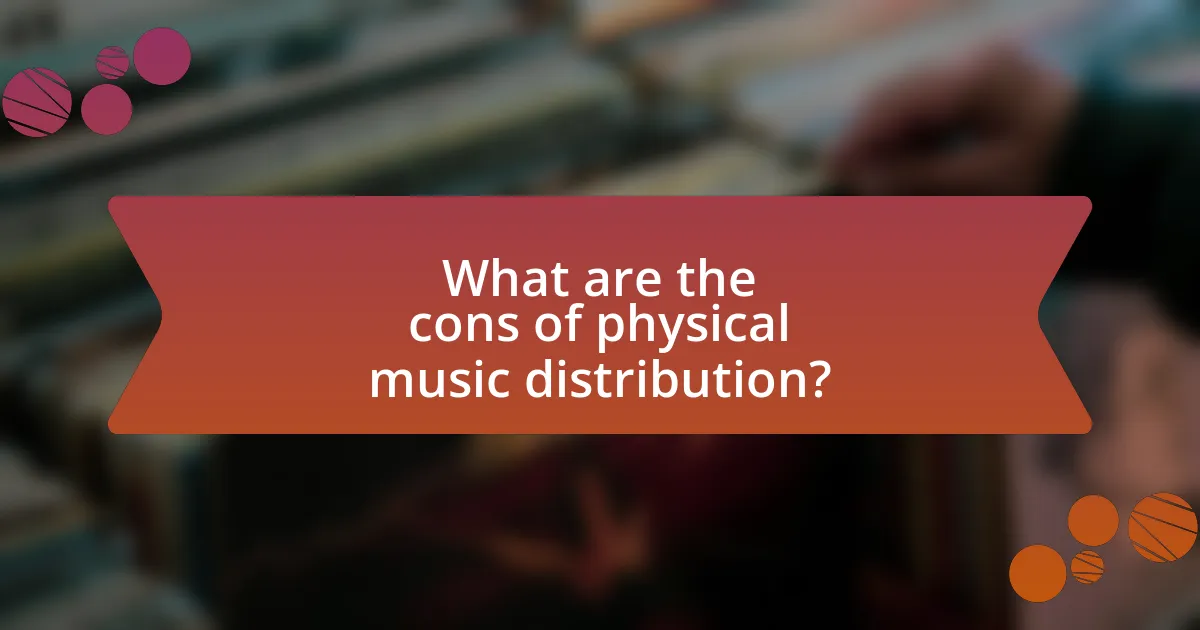
What are the cons of physical music distribution?
The cons of physical music distribution include higher production and distribution costs, limited shelf life, and environmental impact. Physical formats such as CDs and vinyl require manufacturing, packaging, and shipping, which can significantly increase expenses compared to digital distribution. Additionally, physical music can become obsolete as consumer preferences shift towards digital formats, leading to unsold inventory. The production of physical media also contributes to environmental waste, as materials like plastic and paper are used and often discarded. These factors collectively make physical music distribution less efficient and sustainable in the current market landscape.
What logistical challenges are associated with physical music distribution?
Physical music distribution faces several logistical challenges, including inventory management, transportation, and storage. Inventory management is complicated by the need to track physical stock levels, which can lead to overproduction or shortages. Transportation issues arise from the need to ship physical products, which can be affected by delays, costs, and damage during transit. Additionally, storage requires adequate space and conditions to preserve the quality of physical media, such as vinyl or CDs, which can incur extra costs. These challenges can hinder timely delivery and increase operational expenses, impacting the overall efficiency of physical music distribution.
How do shipping and inventory management affect physical distribution?
Shipping and inventory management significantly impact physical distribution by determining the efficiency and effectiveness of delivering products to consumers. Efficient shipping processes ensure timely delivery, which enhances customer satisfaction and retention, while effective inventory management minimizes stockouts and overstock situations, optimizing storage costs and ensuring product availability. For instance, a study by the Council of Supply Chain Management Professionals found that companies with advanced inventory management systems can reduce logistics costs by up to 20%, directly influencing their distribution capabilities. Thus, the interplay between shipping and inventory management is crucial for maintaining a smooth physical distribution process.
What are the costs involved in producing physical music formats?
The costs involved in producing physical music formats include manufacturing, packaging, distribution, and marketing expenses. Manufacturing costs encompass the production of CDs, vinyl records, or cassettes, which can range from $1 to $5 per unit depending on the format and quantity ordered. Packaging costs, including artwork and materials, typically add another $0.50 to $2 per unit. Distribution expenses involve shipping and handling, which can vary widely based on the retailer and location, often costing between $0.25 to $1 per unit. Additionally, marketing costs for promoting physical releases can range from hundreds to thousands of dollars, depending on the scale of the campaign. Collectively, these costs can significantly impact the overall budget for producing physical music formats, making them more expensive than digital distribution methods.
How does physical music distribution limit market reach?
Physical music distribution limits market reach by restricting accessibility and availability to specific geographic locations. Unlike digital distribution, which allows instant access to music globally, physical distribution relies on retail outlets and shipping logistics, which can hinder the ability to reach consumers in remote or underserved areas. For instance, a study by the International Federation of the Phonographic Industry (IFPI) in 2020 indicated that digital music sales accounted for 62% of the global music market, highlighting the growing preference for digital formats over physical ones. This shift demonstrates that physical formats, such as CDs and vinyl, are often not as widely available, thus limiting potential sales and audience engagement.
What geographical limitations exist for physical music distribution?
Geographical limitations for physical music distribution include logistical challenges, import/export regulations, and market accessibility. These factors can hinder the ability to distribute physical music products effectively across different regions. For instance, remote areas may lack distribution infrastructure, making it difficult to reach consumers. Additionally, countries may impose tariffs or restrictions on imported goods, complicating the distribution process. According to the International Federation of the Phonographic Industry, physical music sales have declined significantly in regions where digital access is prevalent, indicating that geographical limitations can directly impact market performance.
How does consumer behavior affect physical music sales?
Consumer behavior significantly impacts physical music sales by influencing purchasing decisions based on preferences for tangible products, nostalgia, and collector mentality. For instance, a survey by the Recording Industry Association of America (RIAA) indicated that 18% of music consumers still prefer physical formats due to the perceived value of owning a physical item and the experience associated with it. Additionally, trends show that limited edition releases and vinyl records have seen a resurgence, driven by consumers’ desire for unique and collectible items, which further boosts physical sales. This behavior reflects a segment of the market that values the physicality of music, contrasting with the growing trend towards digital consumption.
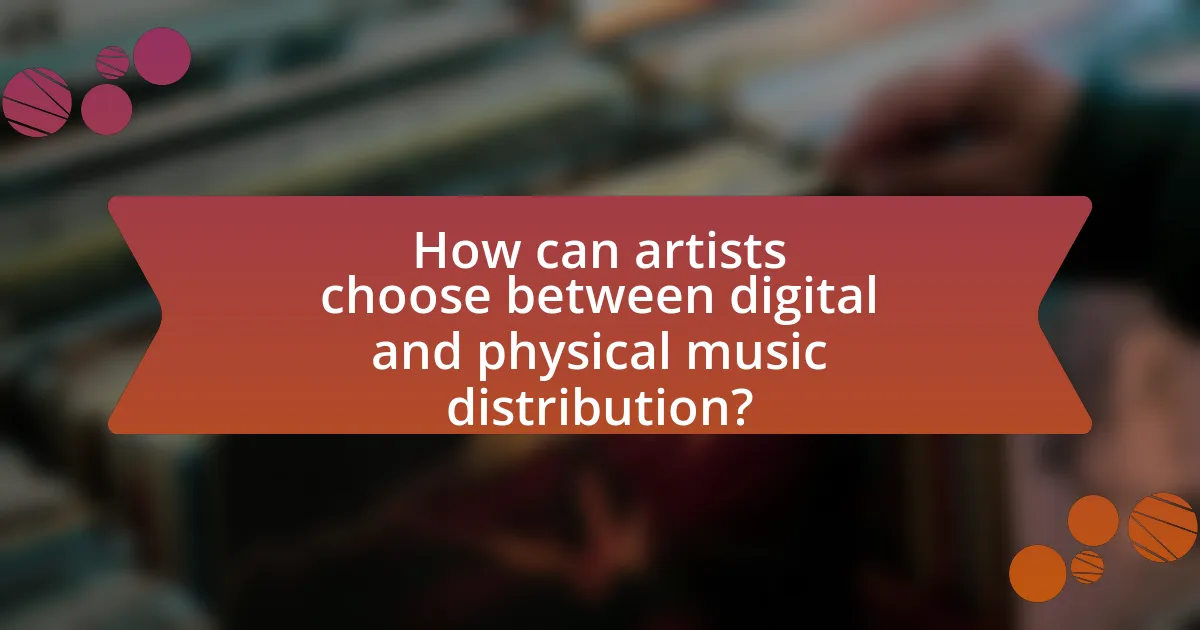
How can artists choose between digital and physical music distribution?
Artists can choose between digital and physical music distribution by evaluating their target audience, marketing strategy, and production costs. Digital distribution offers wider reach and lower costs, making it suitable for artists aiming for global exposure and quick releases. In contrast, physical distribution can create a tangible connection with fans and may appeal to collectors, but it involves higher production and shipping costs. According to a 2021 report by the Recording Industry Association of America, digital music accounted for 83% of the total music revenue in the U.S., highlighting the growing preference for digital formats. Thus, artists should assess their goals and resources to make an informed decision.
What factors should artists consider when deciding on a distribution method?
Artists should consider audience reach, cost, and control when deciding on a distribution method. Audience reach determines how effectively the artist can connect with listeners; digital distribution often provides a broader global audience compared to physical distribution, which may be limited to local markets. Cost is another critical factor, as digital distribution typically incurs lower upfront expenses and eliminates the need for physical inventory, while physical distribution involves manufacturing and shipping costs. Control over the distribution process is also essential; artists may prefer digital platforms for the ability to manage their releases and marketing strategies directly, whereas physical distribution may require reliance on third-party distributors. These factors collectively influence an artist’s decision-making process regarding the most suitable distribution method for their music.
How do target audience and genre influence distribution choices?
Target audience and genre significantly influence distribution choices by determining the most effective channels to reach listeners. For instance, a pop music artist targeting a younger demographic may prioritize digital platforms like Spotify and TikTok, where this audience is most active, while a classical music ensemble might opt for physical distribution through CDs or vinyl, appealing to an audience that values tangible formats. Research indicates that 75% of Gen Z prefers streaming services for music consumption, highlighting the necessity for artists in contemporary genres to focus on digital distribution. Conversely, niche genres often benefit from physical formats, as collectors and enthusiasts are more likely to purchase vinyl or CDs, thus influencing distribution strategies to include both digital and physical options tailored to audience preferences.
What role does budget play in selecting a distribution method?
Budget plays a critical role in selecting a distribution method by directly influencing the choice between digital and physical distribution channels. A limited budget often favors digital distribution due to its lower upfront costs, such as reduced manufacturing and shipping expenses, while physical distribution typically incurs higher costs related to production, storage, and logistics. For instance, digital platforms like Spotify or Apple Music allow artists to distribute their music with minimal financial investment, making it accessible for independent musicians. In contrast, physical distribution requires significant investment in CDs or vinyl production, which can be prohibitive for those with constrained financial resources. Thus, the budget not only determines the feasibility of each distribution method but also impacts the overall reach and marketing strategies employed by artists.
What best practices can artists follow for effective distribution?
Artists can follow several best practices for effective distribution, including utilizing digital platforms, engaging with social media, and collaborating with distributors. Digital platforms like Spotify and Apple Music provide broad reach and accessibility, allowing artists to distribute their music globally. Engaging with social media helps artists build a fanbase and promote their work, as platforms like Instagram and TikTok can drive traffic to their music. Collaborating with distributors ensures that artists can navigate the complexities of music distribution, as established distributors often have established relationships with streaming services and retailers. According to a report by the International Federation of the Phonographic Industry, digital music revenues accounted for 62% of the global recorded music market in 2020, highlighting the importance of effective digital distribution strategies.
How can artists leverage both digital and physical distribution strategies?
Artists can leverage both digital and physical distribution strategies by integrating their online presence with tangible products to maximize reach and revenue. Digital distribution allows artists to access global platforms like Spotify and Apple Music, enabling them to reach a wider audience quickly and efficiently. In contrast, physical distribution, through vinyl, CDs, or merchandise, creates a tangible connection with fans and can enhance brand loyalty.
For instance, artists can promote their physical albums through social media campaigns, driving traffic to their online stores while also offering exclusive physical merchandise at live events. This dual approach not only diversifies income streams but also caters to different consumer preferences, as 45% of music consumers still purchase physical formats according to the Recording Industry Association of America (RIAA). By combining these strategies, artists can effectively engage with both digital-savvy listeners and traditional fans, optimizing their overall distribution efforts.
What tools and resources are available for artists to optimize their distribution?
Artists can optimize their distribution using digital distribution platforms, social media marketing tools, and analytics software. Digital distribution platforms like DistroKid, TuneCore, and CD Baby allow artists to distribute their music across various streaming services and online stores efficiently. Social media marketing tools such as Hootsuite and Buffer help artists schedule and manage their promotional content, increasing visibility and engagement. Additionally, analytics software like Google Analytics and Spotify for Artists provides insights into audience behavior and streaming performance, enabling artists to make data-driven decisions to enhance their distribution strategies. These resources collectively empower artists to reach wider audiences and maximize their music’s impact in both digital and physical markets.
